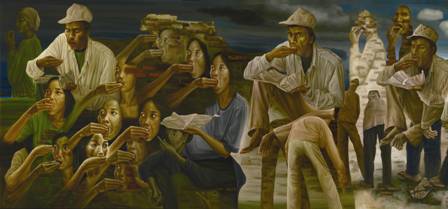 |
|
|---|---|
| CP Foundation | About CP Biennale | 2003 | 2005 | Contact Us | |
         
|
|
|
Manusia Batu (Rock Human) Ivan Sagita (born 1957, in Malang) studied painting at the Arts and Design Faculty of the Indonesian Institute of Arts (ISI) Yogyakarta (1979-1985). Some of his solo exhibitions are: “Death-Containing Life” at the CP Artspace, Jakarta (2005); the exhibition at the Red Mills Gallery, Vermont, USA (2003); and “Freezing the Time,” a drawing exhibition at the Northern Territory University Gallery, Darwin, Australia (2000). He has followed several group exhibitions such as: “All Is in Our Head” at the Singapore Art Fair (2004); CP Open Biennale 2003; “Eye Witness” at the Nadi Gallery Jakarta (2002); the Osaka Triennale 2001 in Japan; “Picture of Death and the New Delight Eddi Hara and Ivan Sagita” at the Santi Gallery Jakarta (2000). Can they live without rocks? This is a question that surfaces every time I see a group of building workers. There are five of them, everyday going to work and coming back together on bikes, passing a 30 km road from the village of Sawahan, Bantul, to Yogyakarta. Going to work is the beginning of a continuous daily togetherness. The bikes go rhythmically together year upon year—through rains and searing heat, sometimes passing the red lights, reflecting the individual's desire and zest to break away from the ancient communal ties. Routine rituals at work: the worker takes off his clothes, wears the work clothes. The feet automatically walk toward the place where the gears are stored. A black bucket in one hand, another hand carries the mallet. This is a moment of resistance through work—his movements appear slow, the stretching of his small body is almost invisible. His body bends a bit, then he holds the mallet using both hands, taking it over the head, going downward, falling right on the side of the rock. It goes on repeatedly. Noon is the peak of glee. The formation of self is at pause. One hour is efficiently used, in groups with fellow workers, filling their stomachs, taking rice into their mouths using their hands. What do they taste there? Probably something quite salty from their sweats. The remainder of the break is used to work on numbers, interpreting lottery numbers on a piece of cement bags. Mystical hopes in the numbers. Back to work. The daily life is a cycle from morning to evening, a cycle taken for granted and believed as a freedom from life's distress. Boundaries are crossed, between the village in the fringe and the center of activities. Outside reality means nothing; traffic lights are not always obeyed, as safety isn't seen as coming from such obedience. (Artist's Statement) |
|
|
CP foundation | About CP Biennale | 2005 Biennale | 2003 Biennale | Contact Us
Jl. Suryopranoto 67A, Jakarta 10160, Indonesia. ph. +62.21.3448126, 3853206 | fax. +62.21.3853203, 3853208 info@cp-foundation.org |

